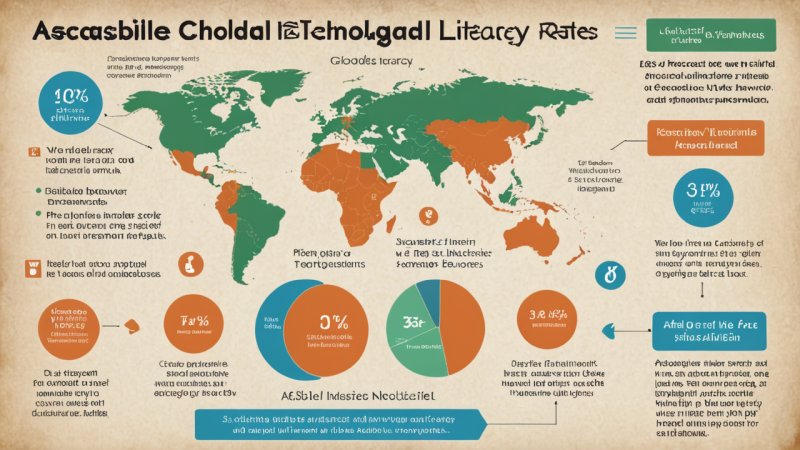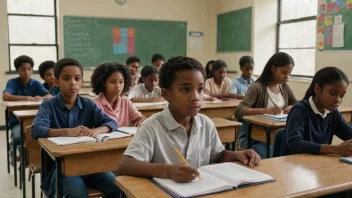In an increasingly interconnected world, literacy remains a cornerstone of personal and community development. With over 773 million adults and 250 million children lacking basic literacy skills, the urgency to address this issue has never been greater. Technology, with its rapid advancements and expansive reach, offers innovative solutions to enhance literacy rates globally. This article delves into the multifaceted role of technology in education, examining how digital tools, online resources, and mobile applications are bridging the literacy gap across diverse populations.
Understanding Global Literacy Challenges
The challenges surrounding global literacy are complex and multifaceted. Factors such as poverty, lack of access to quality education, language barriers, and socio-economic disparities contribute to low literacy rates. Understanding these challenges is crucial to developing effective technological solutions.
- Poverty: Individuals living in poverty often struggle to access educational resources, leading to a cycle of illiteracy that is difficult to break.
- Access to Education: In many regions, particularly rural areas, schools are either nonexistent or poorly equipped, limiting children’s opportunities for learning.
- Language Barriers: In multilingual countries, children may not receive education in their mother tongue, which can hinder their learning process.
- Socio-Economic Disparities: Marginalized groups, including women and minorities, often face additional barriers to education due to discrimination and cultural norms.
The Power of Digital Literacy Tools
Digital literacy tools play a significant role in improving reading and writing skills. These tools range from educational apps to online platforms that provide interactive learning experiences.
Educational Apps
Mobile applications designed for literacy education have gained immense popularity, particularly in areas with limited access to traditional educational resources. These apps often feature gamified learning experiences that engage users and make learning enjoyable.
- Examples of Successful Apps: Apps like Duolingo and Khan Academy have revolutionized language learning and literacy education by providing free, accessible content to users worldwide.
- Interactive Features: Many literacy apps include quizzes, progress tracking, and rewards systems that motivate learners and keep them engaged.
Online Learning Platforms
Online platforms such as Coursera, edX, and FutureLearn offer courses tailored to adult learners seeking to improve their literacy skills. These platforms provide flexibility, allowing learners to access courses at their own pace.
- Course Variety: From basic reading and writing to advanced language skills, online platforms cater to diverse learning needs and preferences.
- Accessibility: Online courses can be accessed from anywhere with an internet connection, making education more reachable than ever.
Community-Based Technology Initiatives
Community-based initiatives harness the power of technology to address local literacy challenges. These programs often involve partnerships between NGOs, governments, and tech companies to create localized solutions.
Mobile Learning Centers
Mobile learning centers equipped with tablets and internet access can reach remote communities, providing education and resources to those who lack access to traditional schools.
- Success Stories: Programs like the “Literacy Bus” initiative in India bring education directly to underserved populations, demonstrating the effectiveness of mobile solutions.
Community Wi-Fi Projects
Providing free Wi-Fi in public spaces can significantly enhance access to online literacy resources. Libraries, community centers, and parks can serve as hubs for learning.
- Impact: Such initiatives not only improve access to educational content but also foster a sense of community and collaboration among learners.
The Role of Social Media in Literacy Promotion
Social media platforms can serve as powerful tools for promoting literacy and engaging communities. By leveraging the vast reach of social networks, organizations can share resources, success stories, and educational content.
Awareness Campaigns
Social media campaigns can raise awareness about literacy issues and mobilize support for initiatives aimed at improving literacy rates.
- Engagement: Hashtags and challenges can encourage users to participate in literacy-focused activities, spreading the message far beyond traditional media.
Peer-to-Peer Learning
Online communities allow individuals to connect with others who share similar literacy goals. Peer-to-peer learning can foster motivation and accountability.
- Support Systems: Platforms like Facebook and WhatsApp can facilitate study groups, discussion forums, and mentorship opportunities.
Challenges of Implementing Technology for Literacy
Despite the potential benefits, several challenges must be addressed when implementing technology for literacy improvement.
Digital Divide
The digital divide highlights disparities in access to technology and internet connectivity. Addressing this divide is crucial for ensuring that all individuals can benefit from digital literacy tools.
- Solutions: Initiatives to provide affordable internet access and devices to underserved communities can help bridge this gap.
Content Relevance and Quality
Ensuring that digital content is relevant and of high quality is essential for effective learning. Content must be culturally appropriate and tailored to the needs of diverse learners.
- Collaborative Development: Collaborations between educators, tech developers, and community leaders can help create effective educational content.
Conclusion
The role of technology in improving global literacy rates is both significant and transformative. By leveraging digital tools, community initiatives, and social media, we can address the myriad challenges facing literacy education today. While challenges such as the digital divide and content quality remain, collaborative efforts can create innovative solutions that empower individuals and communities. As we move forward, it is essential to recognize that technology is not a panacea but rather a powerful ally in the quest for global literacy. Through collective action and commitment, we can ensure that everyone has the opportunity to read, write, and thrive.






